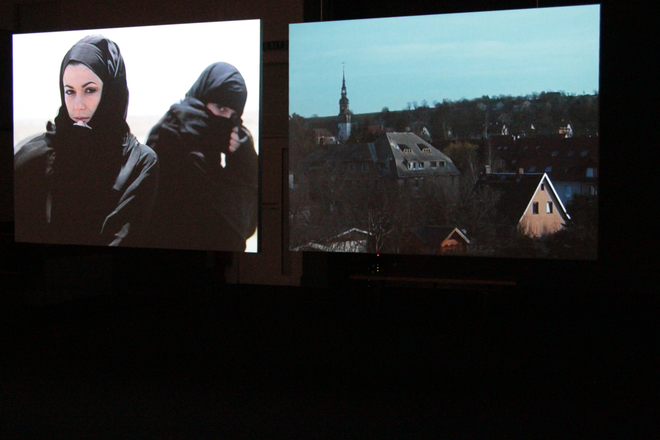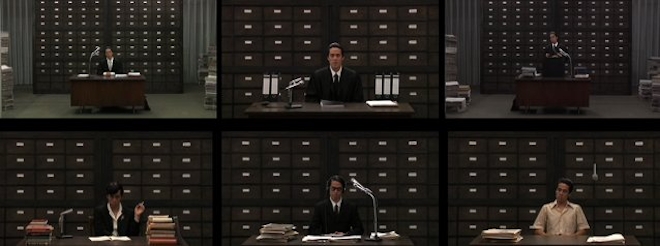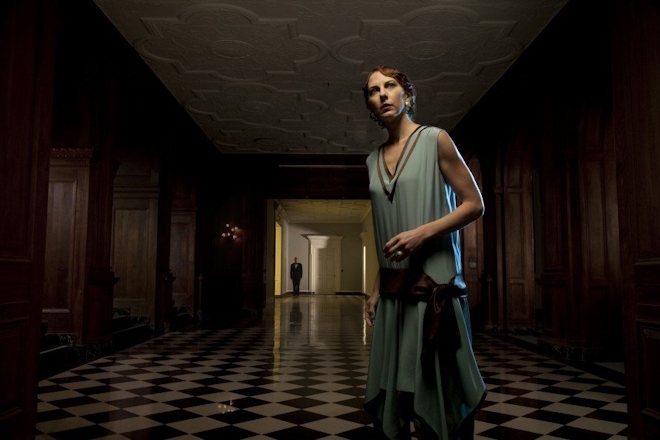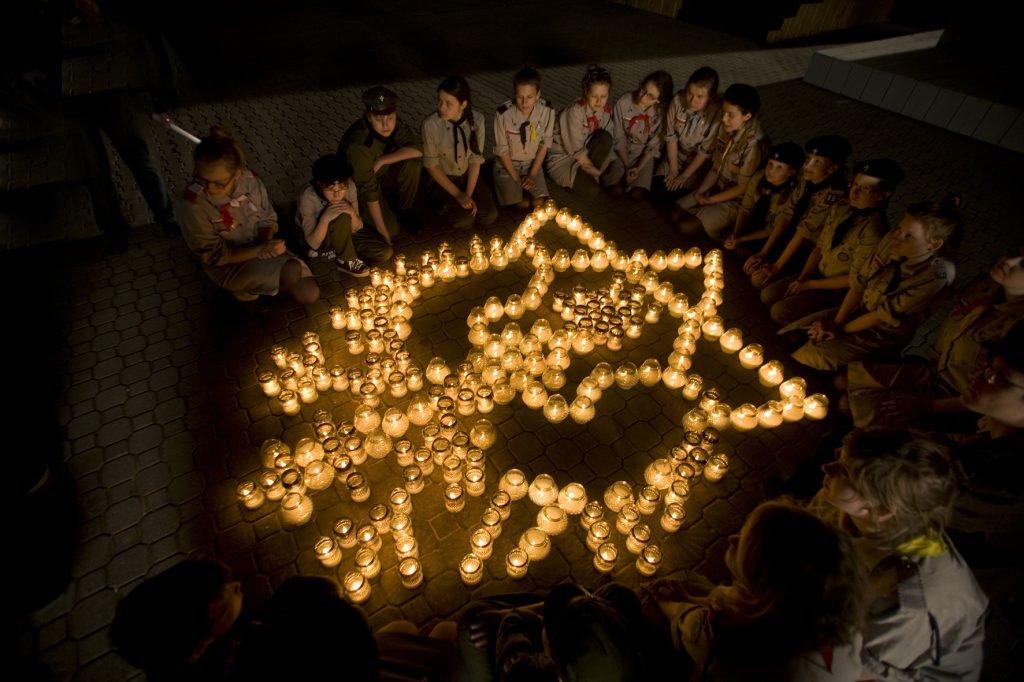I was extremely excited to learn that the Dunedin Public Art Gallery had secured the Govett Brewster's touring exhibition True Stories/Scripted Realities. Curated by Mercedes Vicente and featuring a tantalising international line-up, the promotional still from Kerry Tribe’s There Will Be _____ (2012) offered a sumptuous homage to Hollywood noir and an exhibition of rich cinematic promise. Beyond the unanimously impressive production values, the exhibition revealed seven pieces of great intelligence and consideration which explore the perceived dichotomy between the inauthentic and the real, with the script at the centre of the debate.
Despite its ubiquitous presence in all forms of filmmaking—including documentary—public distrust towards scriptedness occurs frequently, as if it were a villainous facsimile of the truth. This reaction is especially pronounced towards what could be called a new kind of ersatz documentary: reality television. This form of production, with its blurred lines of authenticity, is an interesting point of departure to delve into the strategies involved in True Stories/Scripted Realities, because the outstanding collection of videos wholeheartedly embraces intertextual references and pulp-genre crossovers.
Liam Gillick and Anton Vidokle’s A Guiding Light (2010) takes its name and its form from the longest running soap opera in American history—Guiding Light, which played for 57 years on American television. A Guiding Light is a double channel projection that documents a group of critics, curators, and artists as they discuss propositions posed by a script"—Gao Shiming’s curatorial text for the 2010 Shanghai Biennale.
It is a brave choice to open the exhibition, with only two sets of headphones and a non-descript studio setting to woo viewers. At first listen its concerns could seem overly Art World, yet it transcends this potential insularity with an entertainingly meandering structure—characters soliloquise, interact in groups, and in pairs—echoing the intertwining and open-ended narrative elements of soap opera and reality television. This choice of unconventional form provides a self-critical distance to effectively discuss issues such as the precarity of the artist as a worker/labourer within a community, or the reliance of artists on the exhibition as hub of production. Ultimately, it is a clever opening gambit with many of the overarching ideas in True Stories/Scripted Realities framed in A Guiding Light, in particular the exposition of otherwise hidden mechanisms of social and cultural production.
The Casting (2007) by Omer Fast consists of two double-channel videos projected back to back on floating screens that divide the room. The side not immediately visible shows rapid cut clips of Fast interviewing an American soldier about two different experiences: in one he recounts a disastrous date with a girl while stationed in Germany, in the other a roadside shooting in Iraq. On the reverse side images corresponding to the seamlessly stitched together audio stories appear as a series of tableaux.

Installation view of The Casting (2007) Omer Fast, at the Govett-Brewster Art Gallery 2012. Courtesy the artist and Arratia, Beer Gallery, Berlin. Photo: Bryan James
During the interview Fast tells the soldier, "I like your story, but it was 30 minutes, too long for people’s attention spans." He then goes on to encourage the soldier to improvise and remind him that he’s not after something political. These displays of directorial honesty—read transparency—seem somewhat shocking in a schizophrenic world obsessed with media authenticity, yet simultaneously hyper-aware of media duplicity. Working within that nexus Fast’s work successfully foregrounds the mass media’s construction of messages, as well as the trend toward personalisation and sensationalism in current affairs programmes such as 60 Minutes or 20/20. The clincher is that in spite of Fast’s strategies of disruption both stories are gripping tales. Whether that is due to their inherent "truth", or Fast’s editing, or a combination of the two is left satisfyingly unanswered.
Throughout True Stories/Scripted Realities the contested and uneasy terrain of documentary is examined. Historian Ann-Louise Shapiro favours the term "instrumental" rather than documentary for texts that exercise power by "changing consciousness, by their deliberate attempt to alter their viewers’ relationship to a subject by recontextualising it in the proffered time, space, and intellectual field of film." The term is useful when approaching Andrea Geyer’s Criminal Case 40/61 Reverb (2009): a six channel work designed to place the viewer at the centre of a hexagon of screens where a performer—the excellent Wu Ingrid Tsang—plays six characters involved in the trial of Nazi war criminal Adolf Eichmann. Geyer’s considered treatment of the highly charged material taken from trial transcripts is aided by the inclusion of contemporaneous additional writing by philosopher Hannah Arendt, whose presence among the six characters takes the form of an omniscient narrator. Using Arendt as an intermediary allows the aura of the case to recede, and in that space the work becomes instrumental in the most effective manner; the individuals portrayed become conduits for universal meditations rather than remain rooted as historical figures in an historical conflict.

Still from Criminal Case 40/61: Reverb (2009) Andrea Geyer. Courtesy the artist
Kerry Tribe’s There Will Be _____ (2012) shreds the already dubious chain of events of one of Hollywood’s infamous unsolved murders into numerous threads, then haphazardly weaves them over one another. Unpredictable cuts between clocks, rooms, and the repetition of the same starting sequence provide a disorienting number of possibilities. Filmed on location at the site of the crime, Greystone Mansion, the grandiose estate has also been the location for over fifty films and television programmes. Tribe compiled the script for There Will Be _____ from excerpts of the films and programmes set at the mansion. The layering of fictions suggests that alternative accounts of the case are not mutually exclusive, but also inform one another; that our stories are always conglomerations of stories told and heard prior. The authenticity of our own scripts—our memories—is therefore implicitly questioned.

Still from The Grand Hall (pre-production study for There Will Be________) (2011/2012) Kerry Tribe. Courtesy the artist and 1301PE Gallery, Los Angeles
The three-part series And Europe Will Be Stunned (2007-2011) by Yael Bartana includes Mary Kozmary (Nightmare), Mur i wieza (Wall and Tower), and Zamach (Assassination) and occupies the final space in the exhibition. The three single channel works are played back to back and trace the development and growth of the fictional Jewish Renaissance Movement in Poland headed by real-life Polish political activist Slawomir Sierakowski. The JRMP advocates for the return of three million jews to Poland as part of a greater agenda that promotes tolerance and greater cultural diversity through a vociferous dogmatism. The unease at the vigour with which the Jewish Renaissance is presented implementing its mission in all three videos raises interesting moral questions of the collective good. Can a utopia founded on ideas of tolerance and acceptance, but created through overtly political means maintain its inherent goodness? Relying on an uncomfortable strain of anti-facism to make its point, Bartana’s work seems too obviously instrumental—straying into didacticism via a pastiche of political propaganda. It is only a small criticism, and one that is perhaps heightened by the fact that the rest of True Stories/Scripted Realities is so carefully nuanced.
There is a lot to unpack in True Stories/Scripted Realities—and with an exhibition running time totalling just under three hours it will take time. But it is well worth it; Vicente has curated an exhibition of startling quality that is socially and culturally relevant, as well as entertaining. One can only hope that additional institutions take the lead of Te Tuhi, and the Dunedin Public Art Gallery and secure this wonderful touring exhibition for their audiences.
